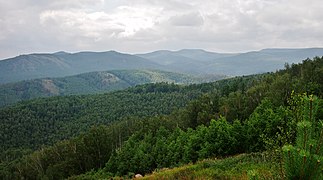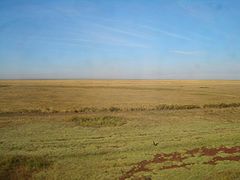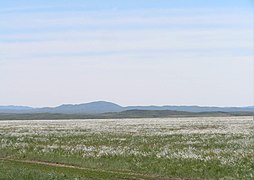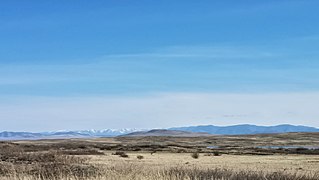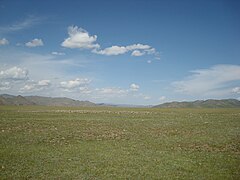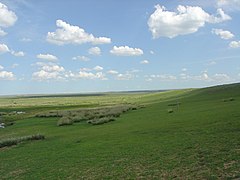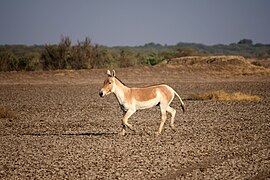Eurasian Steppe

The Eurasian Steppe, also called the Great Steppe or The Steppes, is the vast
Since the
Geography
Divisions
The Eurasian Steppe extends for 8,000 kilometres (5,000 miles) from near the mouth of the Danube in Romania to the western edge of Manchuria. It is bounded on the north by the forests of European Russia and Asian Russia or Siberia. There is no clear southern boundary although the land becomes increasingly dry as one moves south. The steppe narrows at two points, dividing it into three major parts.
Pannonian Steppe (exclave)
The
-
ThePannonian steppe in Seewinkel, Austria
-
The
Pontic–Caspian Steppe (Western Steppe)
The
-
The Pontic–Caspian steppe near Krynychne, Ukraine.
Ural–Caspian Narrowing
The steppe narrows around the southern end of the Ural Mountains, about 650 km (400 mi) northeast of the Caspian Sea, forming the Ural-Caspian Narrowing, that joins the Pontic-Caspian Steppe in Europe with the Kazakh Steppe in Central Asia.
-
Wooded Ural Mountains of Beloretsky District, Russia
-
Bashkiriya National Park, southern end of the Ural Mountains, Russia
-
Bashkiriya National Park, Ural Mountains, Russia
Kazakh Steppe (Central Steppe)
The
-
The steppe in Akmola Region, Kazakhstan.
-
The steppes inAkmola Province, Kazakhstan.
-
The Kazakh Steppe in the early spring.
Dzungarian Narrowing
On the east side of the former Sino-Soviet border, mountains extend north almost to the forest zone separating the Dzungarian Narrowing from the Central Asian steppe, leaving only limited grassland in Dzungaria. This discontinuous section of the Eurasian steppe connects the great steppes of Central Asia and East Asia.
The east-west Tian Shan Mountains divide the steppe into Dzungaria in the north and the Tarim Basin to the south. Dzungaria is bounded by the Tarbagatai Mountains on the west and the Mongolian Altai Mountains on the east, neither of which is a significant barrier. Dzungaria has good grassland around the edges and a central desert. It often behaved as a westward extension of Mongolia and connected Mongolia to the Kazakh Steppe. To the north of Dzungaria are mountains and the Siberian forest. To the south and west of Dzungaria, and separated from it by the Tian Shan mountains, is an area about twice the size of Dzungaria, the oval Tarim Basin. The Tarim Basin's arid conditions make it unsuitable for sustaining a nomadic population. However, along its periphery, rivers descend from the mountains, creating a circle of cities that thrived on irrigation agriculture and engaged in east-west trade. The Tarim Basin formed an island of near civilization in the center of the steppe. The Northern Silk Road went along the north and south sides of the Tarim Basin and then crossed the mountains west to the Fergana Valley. At the west end of the basin the Pamir Mountains connect the Tian Shan Mountains to the Himalayas. To the south, the Kunlun Mountains separate the Tarim Basin from the thinly peopled Tibetan Plateau.
-
Tuva Republic, Russia.
-
Dus-Khol lake,Tuva Republic, Russia.
-
The grassland inTuva Republic, Russia.
-
Dus-Khol lake,Tuva Republic, Russia.
Mongolian-Manchurian Steppe (Eastern Steppe)
The
South of the Khingan Mountains and north of the Taihang Mountains, the Mongolian-Manchurian steppe extends east into Manchuria as the Liao Xi steppe. In Manchuria, the steppe grades off into forest and mountains without reaching the Pacific. The central area of forest-steppe was inhabited by pastoral and agricultural peoples, while to the north and east was a thin population of hunting tribes of the Siberian type.
-
The Mongolian-Manchurian grassland in the Khövsgöl Province, Mongolia.
-
Grass steppe in the Khövsgöl Province, Mongolia.
-
Daursky Nature Reserve in the southern part of the Zabaykalsky Krai in Siberia, Russia, close to the border with Mongolia.
-
The Mongolian-Manchurian grassland in Inner Mongolia, China.
Fauna
Big mammals of the Eurasian steppe were the
Furthermore, the Eurasian steppe is home to a great variety of bird species. Threatened bird species living there are for example the imperial eagle, the lesser kestrel, the great bustard, the pale-back pigeon and the white-throated bushchat.[15]
-
Przewalski horse
The primary domesticated animals raised were sheep and goats with fewer cattle than one might expect. Camels were used in the drier areas for transport as far west as Astrakhan. There were some yaks along the edge of Tibet. The horse was used for transportation and warfare. The horse was first domesticated on the Pontic–Caspian or Kazakh steppe sometime before 3000 BC, but it took a long time for mounted archery to develop and the process is not fully understood. The stirrup does not seem to have been completely developed until 300 AD (see Stirrup, Saddle, Composite bow, Domestication of the horse and related articles).
Ecoregions
The World Wide Fund for Nature divides the Eurasian steppe's temperate grasslands, savannas and shrublands into a number of ecoregions, distinguished by elevation, climate, rainfall, and other characteristics and home to distinct animal and plant communities and species and distinct habitat ecosystems.
- Alai–Western Tian Shan steppe (Kazakhstan, Turkmenistan, Uzbekistan)
- Altai steppe and semi-desert (Kazakhstan)
- Baraba steppe (Russia)
- Daurian forest steppe (China, Mongolia, Russia)
- Emin Valley steppe(China, Kazakhstan)
- Kazakh forest steppe (Kazakhstan, Russia)
- Kazakh Steppe (Kazakhstan, Russia)
- Kazakh Uplands (Kazakhstan)
- Mongolian-Manchurian grassland(China, Mongolia, Russia)
- Pontic–Caspian steppe (Moldova, Romania, Russia, Ukraine)
- Sayan Intermontane steppe(Russia)
- Selenge–Orkhon forest steppe (Mongolia, Russia)
- South Siberian forest steppe (Russia)
- Tian Shan foothill arid steppe (China, Kazakhstan, Kyrgyzstan)
- Pannonian Steppe[16] (Hungary, Romania, Serbia, Croatia, Slovakia, Austria, Slovenia)
Human activities

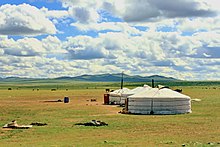
Trade habits
The major centers of population and high culture in Eurasia are Europe, the Middle East, India and China. For some purposes it is useful to treat Greater Iran as a separate region. All these regions are connected directly or indirectly by the Eurasian Steppe route which was an active predecessor of the Silk Road. The latter started in the Guanzhong region of China and ran west along the Hexi Corridor to the Tarim Basin. From there it went southwest to Greater Iran and turned southeast to India or west to the Middle East and Europe. A minor branch went northwest along the great rivers and north of the Caspian Sea to the Black Sea. When faced with a rich caravan the steppe nomads could either rob it, or tax it, or hire themselves out as guards. Economically, these three forms of taxation or parasitism amounted to the same thing. Trade was usually most vigorous when a strong empire controlled the steppe and reduced the number of petty chieftains preying on trade. The silk road first became significant and Chinese silk began reaching the Roman Empire about the time that the Emperor of Han pushed Chinese power west to the Tarim Basin.
Agriculture

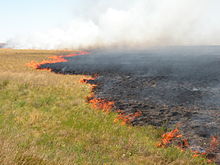
The nomads would occasionally tolerate colonies of peasants on the steppe in the few areas where farming was possible. These were often captives who grew grain for their nomadic masters. Along the fringes there were areas that could be used for either plowland or grassland. These alternated between one and the other depending on the relative strength of the nomadic and agrarian heartlands. Over the last few hundred years, the Russian steppe and much of Inner Mongolia has been cultivated. The fact that most of the Russian steppe is not irrigated implies that it was maintained as grasslands as a result of the military strength of the nomads.
Language
According to the most widely held hypothesis of the origin of the
Religion
History
This section possibly contains original research. (September 2014) |
Warfare
Relations with neighbors
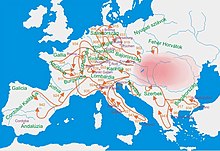
Along the northern fringe of the Eurasian steppe, nomads would collect tribute from and blend with the forest tribes (see Khanate of Sibir, Buryats).[citation needed] Russia paid tribute (compare yasak) to the Golden Horde[17] from about 1240 to 1480.[18] South of the Kazakh steppe the nomads blended with the sedentary population, partly because the Middle East has significant areas of steppe (taken by force in past invasions) and pastoralism. There was a sharp cultural divide between Mongolia and China and almost constant warfare from the dawn of history until the Qing conquest of Dzungaria in 1757.[citation needed] The nomads collected large amounts of tribute from the Chinese and several Chinese dynasties were of steppe origin. Perhaps because of the mixture of agriculture and pastoralism in Manchuria its inhabitants, the Manchu knew how to deal with both nomads and the settled populations and therefore were able to conquer much of northern China[when?] when both Chinese and Mongols were weak.[original research?]
Legacy of the Eurasian steppe's nomads
The steppe culture of Russia was shaped in Russia through cross-cultural contact mostly by Slavic, Tatar-Turkic, Mongolian and Iranian people.[19][20][need quotation to verify] Rus' rulers would ally themselves by marriage with fellow-steppe peoples.[21] In addition to ethnicity, also instruments such as the
Historical peoples and nations
- Thracians 15th-3rd centuries BC
- Chorasmia13th–3rd centuries BC
- Cimmerians 12th–7th centuries BC
- Magyars11th century BC – 8th century AD
- Scythians 8th–4th centuries BC
- Sogdiana8th–4th centuries BC
- Issedones 7th–1st century BC
- Massagetae 7th–1st century BC
- Thyssagetae 7th–3rd century BC
- Donghu 7th – 2nd century BC
- Dahae 7th BC-5th century AD
- Saka 6th–1st centuries BC
- Sarmatians 5th century BC – 5th century AD
- Bulgars 7th century BC–7th century AD[27]
- Transoxiana 4th century BC – 14th century AD
- Xiongnu 3rd century BC – 2nd century AD
- Iazyges 3rd century BC – 5th century AD
- Yuezhi 2nd century BC – 1st century AD
- Tauri
- Wusun 1st century BC – 6th century AD
- Xianbei 1st–3rd centuries
- Goths 3rd–6th centuries
- Vandals 2nd–5th centuries
- Visigoths 3rd–5th centuries
- Franks 3rd–8th centuries
- Huns 4th–8th centuries
- Ostrogoths 4th–8th centuries
- Early Slavs 5th-10th centuries
- Alans 5th–11th centuries
- Avars5th–9th centuries
- Hepthalites5th–7th centuries
- Eurasian Avars6th–8th centuries
- Göktürks 6th–8th centuries
- Sabirs6th–8th centuries
- Khazars 7th–11th centuries
- Onogurs 8th century
- Pechenegs 8th–11th centuries
- Bashkirs 10th century-present day
- Kipchaks and Cumans 11th–13th centuries
- Crimean Goths
- Mongol Empire 13th–14th centuries
- Chagatai Khanate 13th–15th centuries
- Golden Horde 13th–15th centuries
- Kazakh Khanate 15th–19th centuries
- Cossacks, Kalmyks, Crimean Khanate, Volga Tatars, Nogais and other Turkic states and tribes 15th–18th centuries
- Russian Empire 16th–20th centuries
- Soviet Union 20th century
- 20th–21st centuries
See also
References
- ISBN 9780773565098. Archivedfrom the original on 2013-10-29. Retrieved 2012-02-09.
- . Retrieved 29 October 2018.
- . Retrieved 29 December 2023.
- . Retrieved 29 December 2023.
- . Retrieved 11 November 2021.
- . Retrieved 11 November 2021.
- . Retrieved 11 November 2021.
- . Retrieved 29 December 2023.
- . Retrieved 11 November 2021.
- .
- PMC 9750817. Retrieved 27 March 2024.
- . Retrieved 29 December 2023.
- . Retrieved 11 November 2021.
- . Retrieved 29 December 2023.
- ^ "Archived copy" (PDF). Archived (PDF) from the original on 2017-08-08. Retrieved 2017-05-26.
{{cite web}}: CS1 maint: archived copy as title (link) - ^ Természettudományi Múzeum (Hungary) (1969). Annales historico-naturales Musei Nationalis Hungarici.
- ^
Halperin, Charles J. (1985). "Economic and Demographic Consequences". Russia and the Golden Horde: The Mongol Impact on Medieval Russian History. History Russian studies. Bloomington: Indiana University Press (published 1987). p. 78. ISBN 9780253204455. Retrieved 17 May 2021.
The Russian peasantry felt the Tatars' economic oppression much more than the Russian aristocracy and indeed the Russian princes profited from the exploitation of their people. The grand princes were in charge of collecting tribute for the Mongols, and this proved so profitable that the throne was more than worth the large bribes the khan required before awarding it.
- ^
Uspensky, Gleb (1993). The Insider's Guide to Russia. Insiders' Guide Travel Series. Hunter Publishing. p. 44. ISBN 9781556505584. Retrieved 17 May 2021.
[...] Russia [...] in 1480, stopped paying tribute to the now-shaky and fragmented Golden Horde.
- OCLC 1053859731.)
{{cite book}}: CS1 maint: location missing publisher (link - ISBN 9781134828777.
- ^
Histoire Russe. University Center for International Studies, University of Pittsburgh. 1992. p. 11. Retrieved 17 May 2021.
The marriages of Rus' princes to the daughters of the Polovtsy khans [...].
- ISBN 9781351665957.
- OCLC 39655294.
- ^ Алексей Мочалов ღ романса трепетные звуки (2013-12-18), Степь да степь кругом /русская народная песня/ Russian folk song/ Steppe all around, archived from the original on 2021-12-13, retrieved 2019-06-11
- ^ NIK KIRIN (2013-04-08), "Ах ты, степь широкая".[HD]., archived from the original on 2014-11-04, retrieved 2019-06-11
- ^ Олег Семёнов (2019-03-30). "Пелагея и Кубанский казачий хор – Любо, братцы, любо! (2019 HD)". YouTube. Archived from the original on 2021-12-13. Retrieved 2019-06-11.
- ^ "The Proto-Turkic Urheimat and the Early Migrations of Turkic Peoples". Archived from the original on December 24, 2013. Retrieved April 20, 2014.
Bibliography
- Barthold, W. (1992). Turkestan Down to the Mongol Invasion. Translated by Minorsky, T. New Delhi: Munshiram Manoharlal Publishers.
- Christian, David (1998). A History of Russia, Central Asia and Mongolia. Vol. 1: Inner Eurasia from Prehistory to the Mongol Empire. Blackwell Publishing.
- Fletcher, Joseph F. (1995). "The Mongols: ecological and social perspectives". In Forbes Manz, Beatrice (ed.). Studies on Chinese and Islamic Inner Asia. Aldershot, Hampshire: Variorum.
- Grousset, René (1970). The Empire of the Steppes: A History of Central Asia. Translated by Walford, Naomi. New Brunswick, NJ: Rutgers University Press.
- John of Plano Carpini (2005). "History of the Mongols". In Dawson, Christopher (ed.). Mission to Asia. Toronto: University of Toronto Press. pp. 3–76.
- Krader, Lawrence (1955). "Ecology of Central Asian Pastoralism". Southwestern Journal of Anthropology. 11 (4): 301–326. S2CID 130062187.
- Lattimore, Owen (1962). "The Geographical Factor in Mongol History". In Lattimore, Owen (ed.). Studies in Frontier History: Collected Papers 1928–1958. London: Oxford University Press. pp. 241–258.
- ISBN 978-0-86078-632-0.
- Sinor, Denis (1977). "Horse and Pasture in Inner Asian History". In Sinor, Denis (ed.). Inner Asia and its Contacts with Medieval Europe. Collected Studies Series. London: Variorum.
External links
- "The importance of the Eurasian steppe to the study of international relations" in Journal of International Relations and Development









